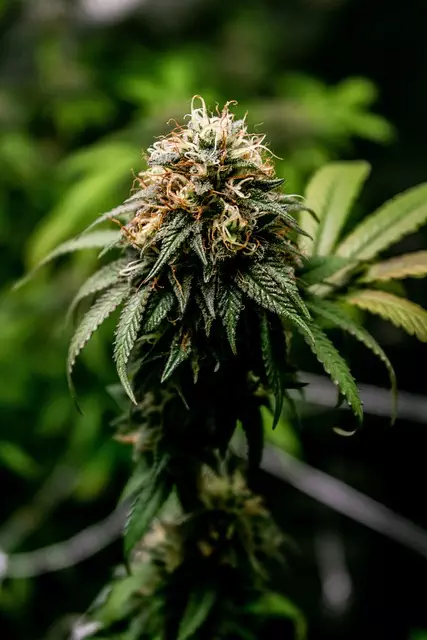High potency cannabinoids, characterized by elevated tetrahydrocannabinol (THC) and cannabidiol (CBD) levels, offer potent therapeutic benefits but require caution due to potential side effects. Consumers can navigate these products through understanding label information, which displays potency in milligrams per unit. Advanced analytical techniques like liquid chromatography-mass spectrometry ensure consistent cannabinoid distribution in cannabis products, enhancing consumer trust and safety. Factors like plant genetics and cultivation conditions impact cannabinoid production, necessitating strict quality control measures throughout manufacturing to maintain product stability and effectiveness. As demand grows, standardization and technological advancements aim to ensure consistent potency levels for high-potency cannabinoids.
In today’s cannabis market, understanding High Potency Cannabinoids is paramount. This article delves into the intricacies of potency consistency, exploring key aspects from basic cannabinoid functionality to advanced measurement techniques. We dissect the significance of high-potency compounds, their therapeutic potential, and the challenges they pose in manufacturing and consumer awareness. By examining factors influencing potency and stability, we provide insights for ensuring safe, consistent products.
Understanding Cannabinoid Potency: The Basics

Cannabinoid potency refers to the strength or concentration of active compounds in a product, primarily tetrahydrocannabinol (THC) and cannabidiol (CBD). High potency cannabinoids are those with elevated levels of these compounds. While THC is known for its psychoactive effects, CBD does not produce a “high” but offers potential therapeutic benefits. Understanding the potency of cannabinoids is crucial when consumers seek specific effects or treatments.
Product labels typically provide potency information in milligrams per unit, indicating how much THC or CBD is contained within. This knowledge allows consumers to make informed choices based on their needs and tolerance levels. High-potency products may offer more pronounced effects but also require careful usage due to the potential for enhanced side effects or an intenser overall experience.
High Potency Cannabinoids: What They Are and Why They Matter

High potency cannabinoids are a significant aspect of modern cannabis discussions, particularly as consumers and researchers seek more targeted and effective treatments. These powerful compounds, present in higher concentrations than their counterparts, offer unique therapeutic benefits due to their ability to interact strongly with the endocannabinoid system (ECS). The ECS, a complex network within the body, plays a crucial role in maintaining homeostasis, or balance, in various physiological processes, including pain management, mood regulation, and immune response.
With high potency cannabinoids, users can experience more pronounced effects, often leading to more effective symptom relief for conditions like chronic pain, anxiety, and certain types of inflammation. However, it’s essential to approach their use with caution. Due to their strength, these cannabinoids may also increase the likelihood of side effects, especially when consumed in untested or unregulated forms. Therefore, understanding the specific high-potency cannabinoid profiles and their potential interactions is vital for consumers to make informed decisions regarding their health and well-being.
Measuring and Assaying Cannabinoid Consistency

In the realm of cannabis products, ensuring potency consistency is paramount to deliver on consumer expectations and safety standards. Measuring high potency cannabinoids involves advanced analytical techniques such as liquid chromatography-mass spectrometry (LC-MS). This method separates and identifies different cannabinoids present in a sample, providing accurate concentration data for each compound. By employing LC-MS, manufacturers can verify the uniform distribution of major cannabinoids like THC and CBD across every batch, lot, or individual product.
Assaying consistency involves rigorous quality control processes that include regular testing at various stages of production. This proactive approach helps maintain a consistent profile, ensuring that each product meets predefined potency criteria. Moreover, it safeguards against variability introduced by cultivation variations, extraction methods, and formulation processes. Ultimately, these measures contribute to building consumer trust and confidence in the efficacy and safety of cannabis-based products.
Factors Affecting Cannabinoid Potency and Stability

Several factors influence the potency and stability of cannabinoids, which are the key compounds responsible for the therapeutic effects of cannabis. One of the primary considerations is plant genetics; different cannabis strains exhibit varying levels of cannabinoid production, with high-potency cannabinoids being a result of specific genetic traits. These potent compounds, such as THC (Tetrahydrocannabinol) and CBD (Cannabidiol), are sought after for their strong therapeutic benefits.
Environmental conditions during cultivation also play a significant role. Factors like lighting, temperature, humidity, and soil quality can impact cannabinoid synthesis and accumulation in the plant. Proper cultivation techniques, including optimal light spectrums and controlled environments, ensure consistent production of high-potency cannabinoids. Additionally, post-harvest processing methods, such as careful extraction and storage, are crucial to preserving the stability and integrity of these valuable compounds, ensuring their effectiveness when delivered to consumers.
Ensuring Product Safety: Quality Control in Cannabinoid Manufacturing

In the realm of cannabinoid manufacturing, ensuring product safety is paramount, especially when dealing with high potency cannabinoids. Quality control measures are the cornerstone of maintaining consistency and efficacy in cannabis-based products. These rigorous protocols involve meticulous testing at every stage of production to guarantee that each batch meets stringent standards. By implementing advanced analytical techniques, manufacturers can detect even minute variations, ensuring a reliable and safe product for consumers.
The process includes comprehensive assessments of cannabinoid profiles, residual solvent levels, and potential contaminants. This careful navigation through the manufacturing labyrinthine guarantees that high potency cannabinoids are not only present but also stable and free from any unwanted substances. Consequently, it fosters consumer confidence, knowing that each purchase offers a consistent and potent experience, without compromising safety.
Consumer Awareness: Reading Label Information for Consistent Dosage

In today’s market, consumers are increasingly aware and discerning when it comes to products containing high potency cannabinoids, such as CBD or THC. One critical aspect of this awareness is understanding how to read label information accurately. This skill ensures they receive a consistent dosage with each use, an essential factor for both safety and effectiveness. By carefully examining the labels, consumers can make informed decisions about their purchase, knowing precisely what they’re putting into their bodies.
Understanding the nuances of label information empowers consumers to choose products that meet their specific needs. It encourages transparency from manufacturers who provide detailed ingredient lists, dosage instructions, and serving sizes. This practice not only promotes responsible consumerism but also guarantees that individuals receive the full benefits of high-potency cannabinoids without any adverse effects resulting from incorrect dosage.
Potential Therapeutic Benefits of High-Potency Cannabinoids

High-potency cannabinoids hold immense therapeutic potential, offering a range of benefits that have captured the attention of medical professionals and researchers. These powerful compounds can provide more effective relief for various conditions compared to lower potency options. For instance, they have shown promise in managing chronic pain, with studies indicating their ability to engage specific receptors in the body’s endocannabinoid system, leading to reduced inflammation and analgesia. This targeted interaction ensures a more robust response, potentially reducing the side effects associated with less potent alternatives.
Additionally, high-potency cannabinoids may offer advanced treatments for anxiety and depression. The intricate balance of chemical compounds within these cannabinoids can interact with neurotransmitters, modulating mood and helping to stabilize emotional states. This unique mechanism of action sets them apart from traditional pharmaceuticals, providing a naturalistic approach to mental health care that has shown encouraging outcomes in preliminary research.
Challenges and Future Directions in Maintaining Consistency

Maintaining consistency in product potency, especially with high-potency cannabinoids, presents several challenges for the industry. As demand grows, ensuring uniform and reliable effects across batches becomes increasingly complex. One significant hurdle is controlling environmental factors during cultivation and production to prevent variability. Extreme temperature fluctuations or exposure to light can trigger stress responses in cannabis plants, leading to altered cannabinoid profiles. Standardizing growing conditions and implementing rigorous quality control measures are essential steps to overcome this challenge.
Looking ahead, advancements in technology and scientific understanding will play a pivotal role in shaping the future of consistency. Real-time monitoring systems that track cannabinoid levels during production can help identify deviations and ensure product uniformity. Additionally, ongoing research into cannabis genetics and biochemistry may unveil new methods for enhancing stability and predictability. These developments promise to empower manufacturers to deliver high-quality products with consistent potency, ultimately fostering consumer trust in the industry.



